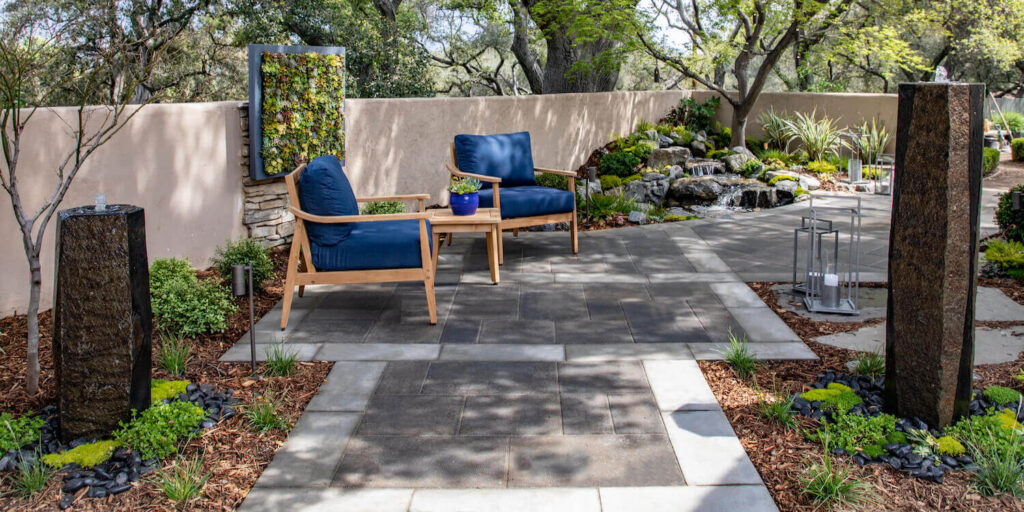What is Patio Edging?
A patio can provide a beautiful and functional outdoor space for relaxing, entertaining, or both. However, one important aspect of a patio’s design is often overlooked – patio edging. Edging is the border that’s placed around the perimeter of your patio, whether it’s made from stone pavers, concrete, or any other material. It serves a variety of purposes, from visually defining the space to keeping unwanted elements out of your patio area.
Landscape edging comes in a variety of materials and styles, giving homeowners plenty of options to choose from. Natural stone like limestone or slate gives your patio a rustic look, and can be used to create either curved or straight edges. Metal edging like aluminum or steel is a popular option, and can add a modern touch to the design. Brick is a classic choice that never goes out of style, and blends in with any landscape. Plastic edging is another choice that’s economical, easy to install, and offers clean lines that are perfect for modern patios.
In addition to defining and beautifying your patio space, edging can also be functional. For example, it can help prevent water from entering your patio area during heavy rainfalls. By creating a narrow trench around the edge of your patio, you can help direct water away from the patio and into the lawn or other drainage system.
Another benefit of having patio edging is that it can help keep lawn mowers and other equipment from damaging the edge of your patio. Whether you’re using a gas-powered or electric lawn mower, the sharp edges of your patio can be easily damaged if accidentally hit. By installing a layer of garden edging material like plastic edge restraints or layer of mulch, you can help protect the edge of your patio from accidental damage.
Overall, the importance of patio edging in landscape designs cannot be understated. From keeping unwanted elements out to lending a touch of beauty and order to your outdoor space, edging is an exciting feature that can transform any patio into a lovely, functional, and clean outdoor space.
The Benefits of Installing Patio Edging
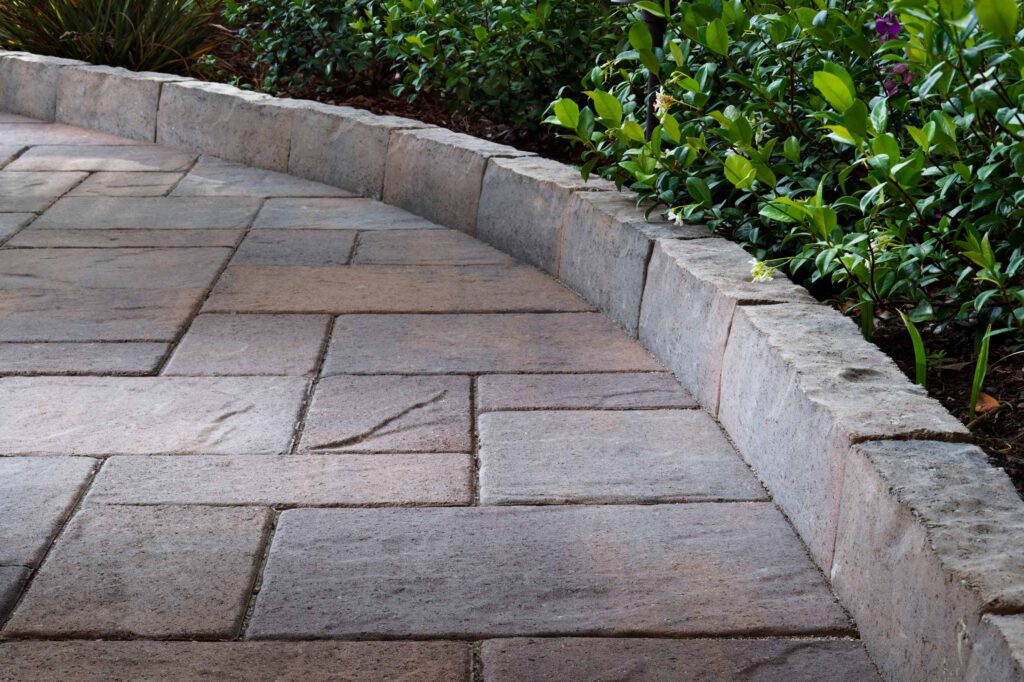
If you’re looking to enhance the overall appearance of your patio space, installing patio edging is the way to go. Not only does it add aesthetic appeal, but it also offers practical benefits that can help you maintain and prolong the life of your patio.
One of the primary benefits of patio edging is that it creates a neat border that defines the edges of your patio. This gives your outdoor space a more organized and structured feel while making it easier to plan and design your patio layout. It’s also an excellent way of separating your patio area from the surrounding lawn or garden beds, creating a clear distinction between the two and giving your space a more cohesive look.
In addition to its decorative element, patio edging can also be functional. When installed correctly, it can help to prevent water from entering your patio area during heavy downpours. This can help to protect your patio surface from water damage and extend its life, ultimately saving you money in the long run. By creating a narrow trench around the edge of your patio, you can help direct water away from the patio and into the lawn or other appropriate drainage system.
Another advantage of having patio edging is that it can help to protect the edge of your patio from unintentional damage. Whether you’re using a lawn mower, garden shears, or other equipment, these sharp blades can easily damage the edge of your patio if accidentally hit. By installing a layer of garden edging material like plastic edge restraints, metal, or brick, you can protect the edge of your patio from harm.
Not only does patio edging provide practical benefits, but it also adds to the overall visual appeal and curb appeal of your outdoor space. Different edging materials like natural stone, metal, or brick can be used to create different styles that complement the rest of your landscaping and outdoor design.
In summary, installing patio edging is a practical and visually appealing way to define your outdoor space while offering functional benefits that can help to protect your patio surface and prolong its lifespan. With a variety of edging materials and styles to choose from, you can enhance the look and functionality of your patio to create an outdoor oasis that everyone will love.
Popular Options for Patio Edging
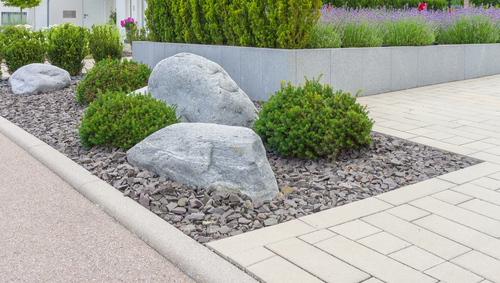
When it comes to patio edging, there are a variety of options to choose from that can significantly enhance the overall aesthetic appeal of your outdoor space. In this article, we’ll go over some of the most popular options available to homeowners looking to create beautiful borders around their patios.
One of the most popular materials used for patio edging is natural stone. Natural stone is a versatile and durable choice that can add a touch of elegance and sophistication to any patio. It’s available in a variety of shapes, sizes, and colors, giving you ample creative control over the final look of your patio. From flagstones to irregularly shaped boulders, natural stone is a timeless edging material that never goes out of style.
Another popular option for patio edging is metal. Metal edging is a contemporary choice that can create clean lines and a modern feel around your patio. Popular metals used for patio edging include steel and aluminum. Metal edging is also low-maintenance and long-lasting, making it a particularly suitable choice for homeowners who don’t want to have to replace their edging frequently.
Plastic edging is another popular option for patio edging. It’s a practical choice that is both lightweight and affordable, making it a great option for those on a budget. Plastic edging is particularly suited for curved edges and can be easily cut to fit the exact shape of your patio.
Brick edging is also a popular choice for homeowners looking to create a classic and traditional look around their patios. Brick is a durable and long-lasting material that is easy to install and maintain. It’s timeless and adds an extra charm to your patio design. Different patterns and variations of brick such as red brick, clay brick or stone brick can be used to create different looks.
In conclusion, patio edging is an essential component of any outdoor space, and the material you choose can have a significant impact on the overall appearance and functionality of your patio. Popular options like natural stone, metal, plastic, and brick can all add beauty, character, and practical benefits to your patio without breaking the bank.
Plastic Edging
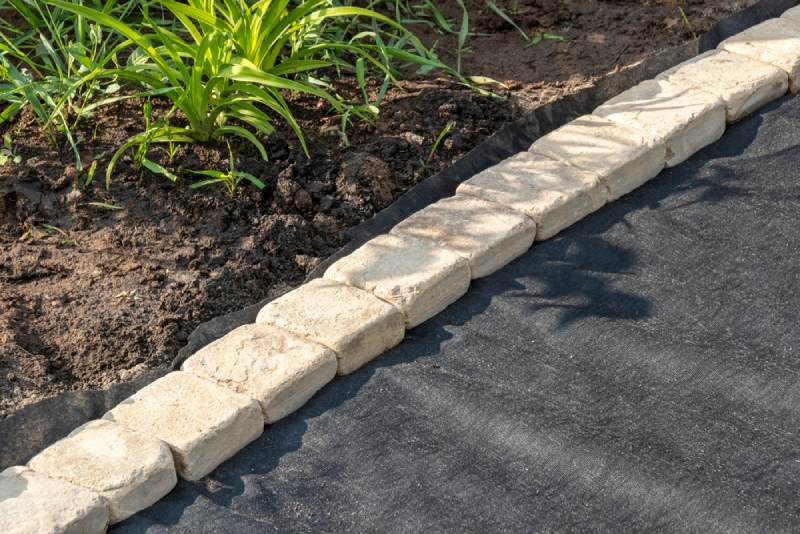
Plastic edging is a popular option for patio edging for a number of reasons. First and foremost, it’s a practical choice that is both lightweight and affordable, making it a great option for those on a budget. It’s also extremely versatile, lending itself well to curved edges and all kinds of landscape designs.
One of the great things about plastic edging is that it’s easy to get just the look you want. You can choose from a variety of different colors and finishes, like black, brown, or green, depending on what will blend in harmoniously with your patio environment. Additionally, plastic edging can be easily cut to fit the exact shape of your patio, allowing for precise control over the final outcome.
Another benefit of plastic edging is that it requires very little maintenance. It’s resistant to the elements and won’t rust or rot over time. Additionally, since it’s made from a synthetic material, plastic edging doesn’t attract pests or insects, which can be a real concern with other types of patio edging like wood or stone.
Perhaps one of the best things about plastic edging is that it’s extremely easy to install. All you need to do is dig a shallow trench around the edge of your patio, lay the plastic edging in the trench, and backfill the dirt around it. If you need to make any adjustments, simply use a rubber mallet to push the plastic into place.
In sum, plastic edging is a great option for anyone looking for an affordable, versatile, and easy-to-install patio edging solution. It’s low-maintenance, resistant to the elements, and can be easily customized to suit any landscaping design. Whether you’re building a new patio from scratch or looking to update an existing one, plastic edging is definitely worth considering.
Natural Stone
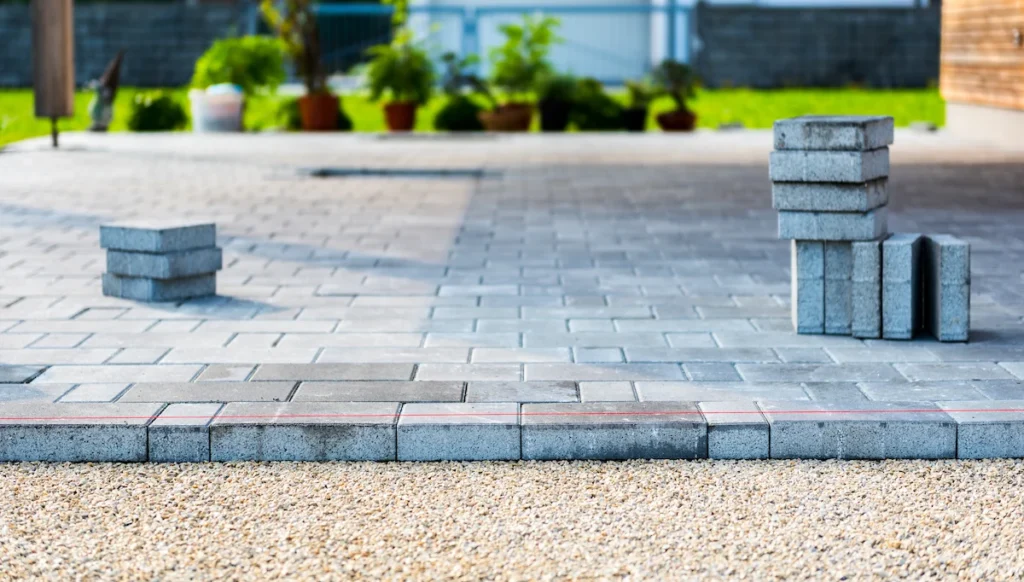
Natural stone is a popular option for creating stunning patio edges and enhancing any outdoor space. It’s a versatile material that can add a touch of elegance and sophistication to any landscaping designs. Natural stone comes in many different forms, from rough, uncut boulders to smooth, polished slabs.
One of the great things about using natural stone for patio edges is that each piece is unique. No two stones are exactly the same, which means that your patio border will have a one-of-a-kind look. You can choose from a variety of natural stone types, including slate, limestone, granite, and sandstone, to achieve the perfect look for your patio.
Another benefit of natural stone is that it’s highly durable and long-lasting. It’s resistant to weathering and fading, making it a reliable choice for creating beautiful borders that stand the test of time. Additionally, natural stone requires minimal maintenance and can be easily cleaned with soap and water.
While natural stone may seem like a costly option, it’s worth the investment for its aesthetic benefits and longevity. It can add curb appeal to your home and make your patio area an exciting feature of your backyard. Natural stone can also be used in a variety of other landscaping elements, such as garden walls, water features, and walkways, to tie your outdoor space together with a cohesive design.
To install natural stone patio edges, a narrow trench will need to be dug around the perimeter of your patio area. The stone pieces can then be laid in the trench and secured in place with mortar. Curved edges can be achieved by carefully shaping the stones to fit the desired curve, or by using different sized stones to create a gradual curve.
In conclusion, natural stone is a beautiful and durable option for creating patio edges and enhancing your outdoor space. With its unique texture and appearance, natural stone can add an elegant and charming touch to any landscaping design. Whether you’re looking for a striking focal point or a complementary feature, natural stone is a versatile material that can blend seamlessly with any style.
Ornamental Grass
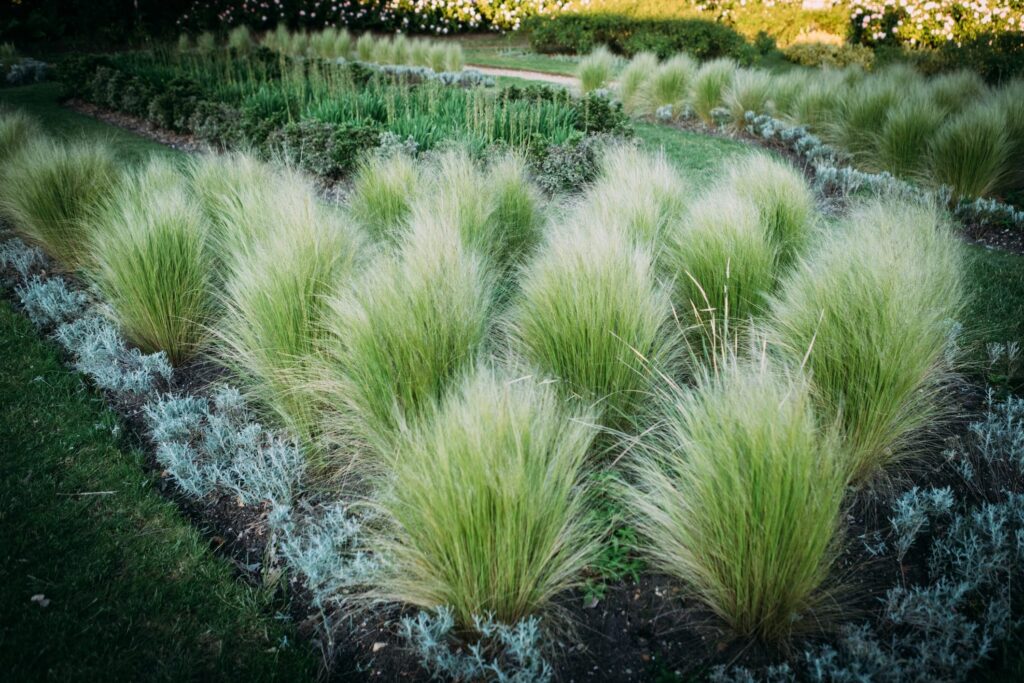
Ornamental grasses are a beautiful addition to any garden. These plants come in a variety of colors, textures, and sizes, making them a versatile choice for landscape designers and gardeners alike. Ornamental grasses are known for their long, narrow leaves and their ability to sway beautifully in the wind.
One of the benefits of ornamental grass is that it requires minimal maintenance. Unlike other plants that need to be pruned and tended to regularly, ornamental grasses can be left to grow on their own. They also do not require much water, making them a great choice for gardeners who live in areas with frequent droughts.
Another benefit of ornamental grass is its ability to withstand harsh weather conditions. These plants are often used in commercial landscaping projects because of their ability to thrive in both hot and cold weather. Additionally, some ornamental grasses are resistant to pests and diseases, making them a low-risk option for gardeners.
Ornamental grasses are also a popular option for creating borders or defining spaces in a garden. They can be used to create stunning garden beds, line walkways, or border patios. Additionally, they can be used to add height to a garden, creating visual interest and drawing the eye upwards.
When selecting the right ornamental grass for your garden, it’s important to consider its size, color, and texture. Some grasses grow to be several feet tall, while others stay small and compact. Some grasses are green, while others have a reddish or purplish hue. Finally, some grasses have a fine texture, while others are coarser.
In conclusion, ornamental grasses are a beautiful and functional addition to any garden. They are easy to maintain, resistant to harsh weather and pests, and can be used to create stunning landscape designs. With so many different types of ornamental grasses available, gardeners are sure to find the perfect match for their garden.
Potted Plants
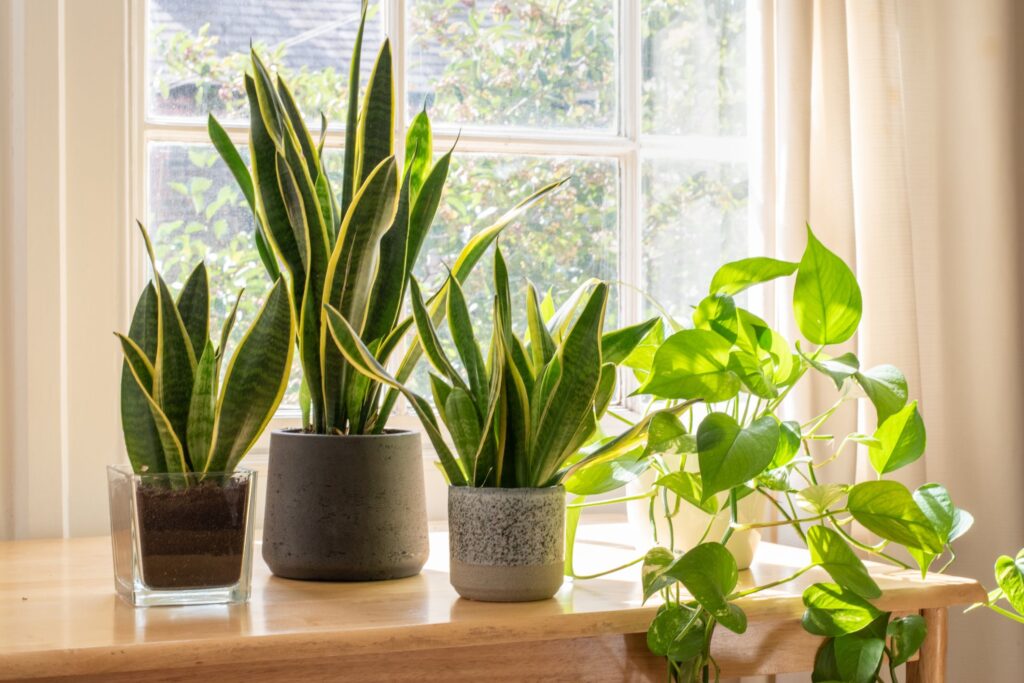
Potted plants are the perfect addition to any indoor or outdoor space. They are versatile, easy to maintain, and can be used to bring life to any room or corner. Potted plants come in a variety of sizes and shapes, from small succulents to large, leafy ferns. They can be placed on a windowsill, a patio, or even hung from the ceiling to add a touch of greenery to your space.
One of the main benefits of potted plants is that they are easy to care for. Most plants require only a weekly watering and occasional pruning to keep them healthy and happy. Additionally, potted plants can be moved around to find the perfect spot for them to thrive. If a plant is not doing well in its current location, simply move it to a different spot with more sunlight or less moisture.
Potted plants also have numerous health benefits. They can help purify the air and remove toxins, making them a great addition to any home or office. Studies have shown that having plants in your space can reduce stress levels, boost mood, and even increase productivity.
In terms of design, potted plants offer endless possibilities. They can be used to create a focal point in a room or to add texture and color to a space. Potted plants can be arranged in groups or individually, and can range from simple to elaborate depending on your style.
When selecting potted plants, it is important to consider the lighting and temperature requirements of each plant. Some plants thrive in low light conditions while others require bright, direct sunlight. Additionally, some plants prefer cooler temperatures while others prefer warmer environments.
In conclusion, potted plants are a great addition to any home or outdoor space. Their versatility, easy care, and numerous health benefits make them a popular choice among plant enthusiasts and beginners alike. Whether you are looking to add a touch of green to your space or to create a lush, jungle-like atmosphere, potted plants are the perfect choice.
Garden Wall
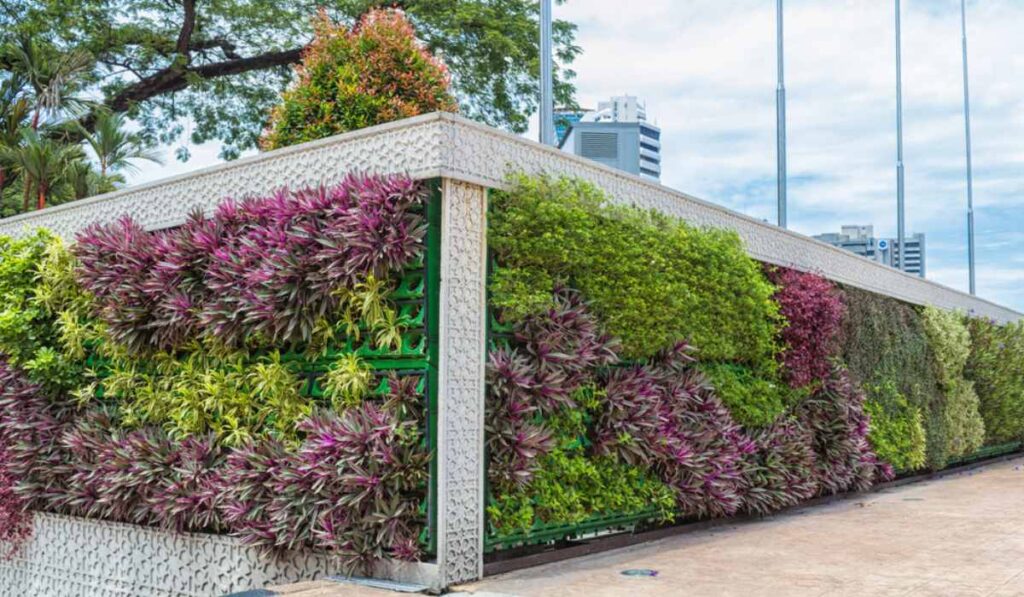
A garden wall is a beautiful addition to any outdoor space, providing both functionality and aesthetic appeal. These walls can be used for a variety of purposes, such as creating a boundary, retaining soil, or adding privacy to your yard.
One of the main benefits of a garden wall is its ability to retain soil, which can be especially helpful for hilly or uneven landscapes. These walls can create a level surface for gardening or other outdoor activities, as well as prevent soil erosion and water runoff.
In addition to their functional benefits, garden walls can also add a unique design element to your yard. They come in a variety of materials such as natural stone, brick, concrete, or even wood, and can be designed in different styles to complement your existing outdoor space.
Another benefit of garden walls is their ability to create privacy within your yard. These walls can provide a barrier between your space and the outside world, allowing you to relax and enjoy your outdoor space without interruption from neighbors or passersby.
If you’re considering adding a garden wall to your outdoor space, it’s important to work with a professional landscaper or hardscaper who can ensure that your wall is built to code and is structurally sound. A professionally-built wall not only ensures your safety but will also stand the test of time.
Finally, when designing your garden wall, consider incorporating other elements such as ornamental grasses, flowers, or even a small water feature. These additions can add visual interest to your wall and make it a focal point of your outdoor space.
In conclusion, a garden wall is not only functional but also adds charm and character to your outdoor space. Whether you choose natural stone or brick, a garden wall is an investment that will enhance your outdoor living experience for years to come.
Landscape Designer Services
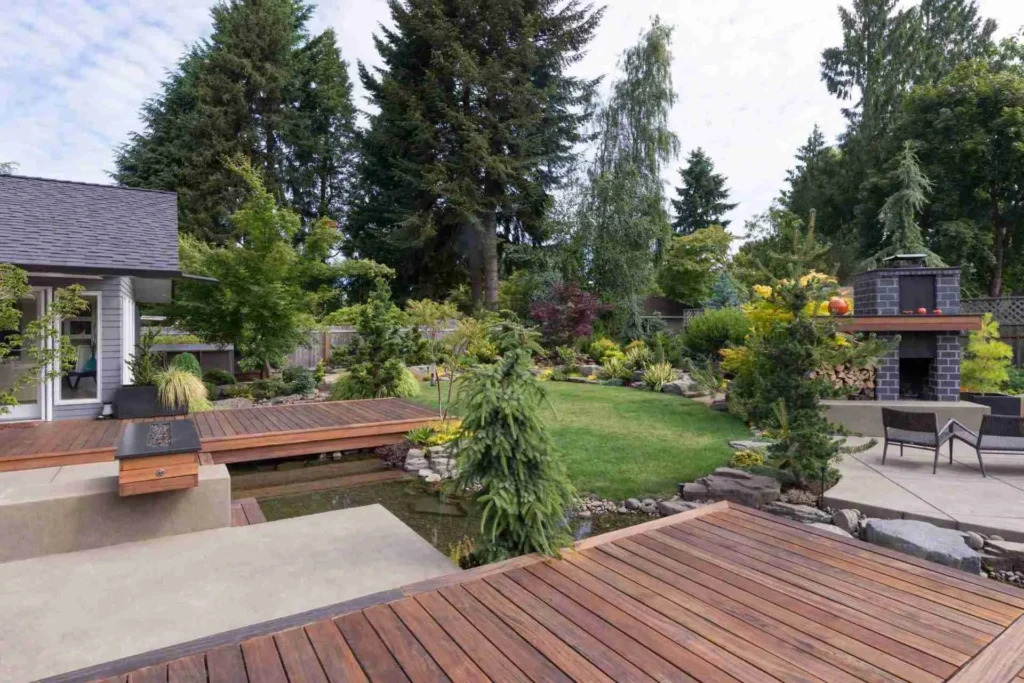
Landscape design is a crucial element when it comes to creating a stunning and functional outdoor space. A well-designed landscape not only enhances the beauty of your property but also adds value to it. To achieve a top-quality landscape, hiring a professional landscape designer is essential. In this article, we’ll discuss the benefits of hiring a landscape designer for your outdoor space.
First and foremost, a landscape designer possesses the necessary expertise to create a landscape design that suits your specific needs. They consider all aspects of your garden, including the architecture of your home, the climate and soil conditions of your region, and your individual preferences to create a design that is both functional and aesthetically pleasing.
Furthermore, a landscape designer can help you save money and time. By working with a professional, you avoid the costly mistakes that come with DIY landscaping. They can guide you on the best materials, plants, and features for your budget and ensure that the installation process is done correctly.
Another advantage of hiring a landscape designer is that they can help you with complex hardscape designs. These designs involve extensive work with building materials such as stone, concrete, and timber. A landscape designer can help you choose the best hardscape materials for your project and assist with the installation process.
A landscape designer also has a keen eye for detail and can take your outdoor space to the next level. They consider important aspects such as color, form, texture, and balance when creating a design. They can incorporate different plant types, such as annuals, perennials, and edibles, to ensure that your garden has year-round interest.
In conclusion, hiring a landscape designer for your outdoor space has many advantages, including expert advice, time and cost savings, hardscape design assistance, and exceptional attention to detail. So, if you want to create a uniquely designed outdoor space, consult a professional landscape designer.
Curved Edges and Sharp Corners
When it comes to designing a garden or patio, choosing between curved edges and sharp corners can make all the difference in creating a cohesive and visually stunning outdoor space.
Curved edges are a popular option for many reasons. They provide a softer aesthetic, creating a natural flow that mimics the curves found in nature. Curves can also make a space feel larger, as they create a sense of movement and continuity. Curved edges pair well with organic shapes and ornamental grasses and can add a touch of whimsy to any garden.
On the other hand, sharp corners can create clean lines and a more modern vibe. They can add structure and a sense of order to a space and are a great choice for those looking to achieve a more minimalist look. Sharp corners pair well with angular plants such as succulents and can be used to define different areas of a garden or patio.
It’s important to note that both curved edges and sharp corners have their potential drawbacks. Curved edges can be challenging to maintain and may require frequent trimming to keep their shape. Sharp corners can be dangerous and pose a hazard to young children or pets that may run or trip into them.
When choosing between curved edges and sharp corners, it’s important to consider the overall theme of your outdoor space. Are you looking for a natural, organic feel, or a more polished and modern look? Many designs even incorporate a combination of both, utilizing curved edges to soften sharp corners and create a balanced look.
Ultimately, the decision between curved edges and sharp corners will come down to personal preference and the specific needs of your outdoor space. With careful consideration, however, you can create a patio or garden that looks beautiful and is perfectly tailored to your unique style.
Different Types of Patio Edge Designs and Ideas
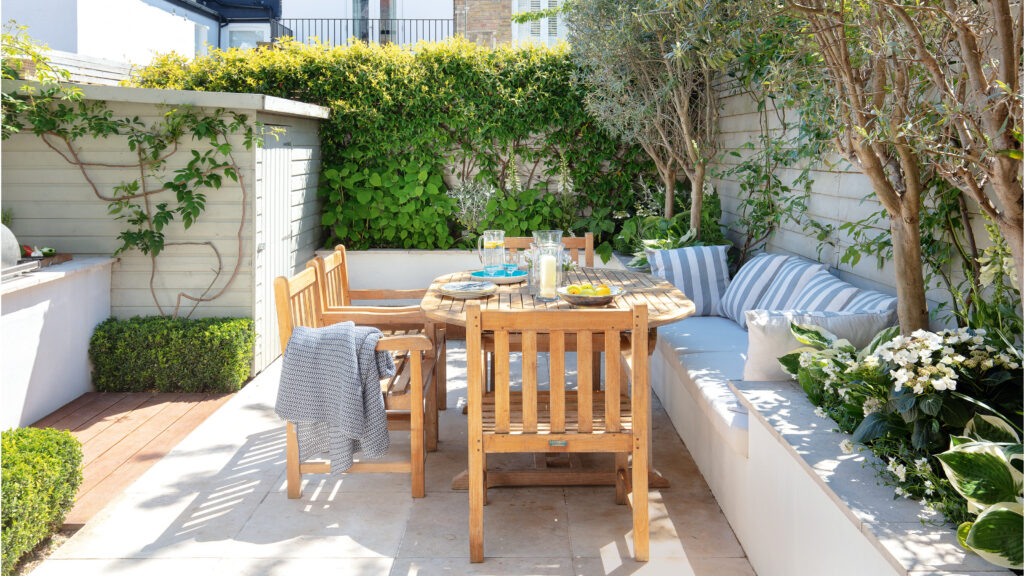
Patios are the perfect place to relax and unwind outdoors, but they can also be a gorgeous and exciting feature of your home. Patio edges can define the shape and boundaries of your outdoor space, while also adding another layer of landscaping design. Whether you’re a novice or a seasoned landscaper, there are plenty of patio edge designs and ideas to choose from.
One popular option is landscape edging, which involves lining the edge of your patio with a clearly defined border. This can be done with natural stone, metal edging, plastic edge restraints, or even a simple layer of mulch. Landscape edging creates clean lines and a sharp border, giving your patio a polished and neat appearance. This type of edging is also beneficial for busy homeowners who don’t have the time or energy to frequently maintain their patio edges.
Another option is to create a narrow trench around the perimeter of your patio. This can be filled with small rocks or pebbles to create a distinct separation between your patio and the surrounding garden beds or outdoor space. A narrow trench can also be advantageous for homeowners who want to incorporate water features or outdoor lighting around their patio edges, as it provides an easy and convenient place to hide wires or pipes.
For a more organic look, consider using a layer of ornamental grasses or fragrant plants around the edge of your patio. This creates a natural border that blends seamlessly with the surrounding landscape and can provide a lovely aroma to your outdoor space. Using flower beds or potted plants is also a great way to add pops of color and texture to your patio edges.
If you’re looking to create a patio that seamlessly blends with the rest of your outdoor space, consider using a curved edge design. Curved edges create a sense of flow and harmony, mimicking the organic shapes found in nature. This type of design can also make a small space feel larger and more open, and can add a touch of whimsy to any outdoor area.
Ultimately, the type of patio edge design you choose will depend on your personal style and preferences, as well as the overall aesthetic of your outdoor space. Remember to consider factors such as maintenance, safety, and practicality when choosing your patio edging materials and designs. With a little bit of creativity and some landscaping know-how, you can transform your patio into a beautiful and functional outdoor oasis.
Flower Beds and Garden Borders
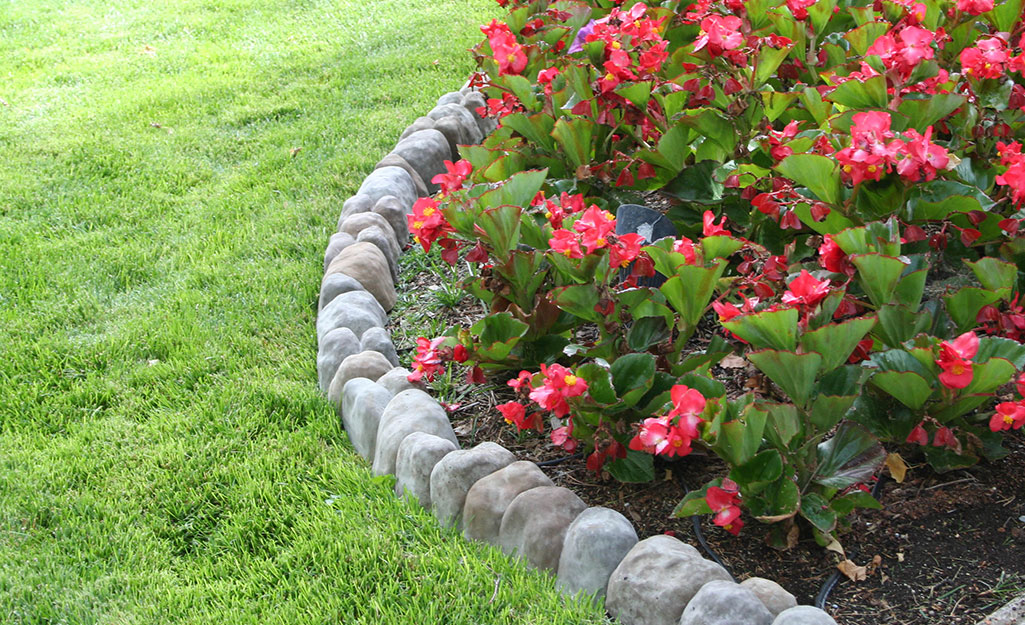
Flower beds and garden borders are an essential part of landscaping, providing a beautiful and colorful addition to any outdoor space. They not only add visual appeal and curb appeal to your home, but they also help to define your garden or patio area, preventing plants and grass from growing into other areas.
There are many options when it comes to flower beds and garden borders. Some homeowners prefer the traditional look of a formal garden with geometric shapes and neatly trimmed hedges, while others prefer a more natural, informal look with curved lines and wildflowers.
One popular option for flower beds is to plant perennials that bloom in different seasons, ensuring that your garden always has something in bloom. Annuals, like petunias, begonias, and impatiens, can also add a pop of color and variety to your garden beds. Flower beds can be lined with pavers, rocks, or bricks to create a clearly defined border, or edged with plastic, metal, or natural materials like stone or wood.
Garden borders, on the other hand, can be used to separate the garden from other areas of your yard, like your lawn or patio. They can be made from a variety of materials, including bricks, rocks, or pavers, and can be curved or straight depending on your design preference. Edging materials like plastic or metal can also be used to keep grass and weeds from encroaching on your garden.
Creating garden borders and flower beds doesn’t have to be a complicated or difficult process. It can be as simple as digging a trench along the edge of your garden and filling it with rocks or mulch. You can also purchase pre-made edging materials that are easy to install and require little maintenance.
If you’re not sure where to start, consider consulting with a landscape designer or visiting a local garden center. They can provide valuable advice on plant selection and design ideas for your flower beds and garden borders. With a little effort and creativity, you can create a beautiful and unique outdoor space that reflects your personal style and enhances the beauty of your home.
Neat Borders and Landscape Designs
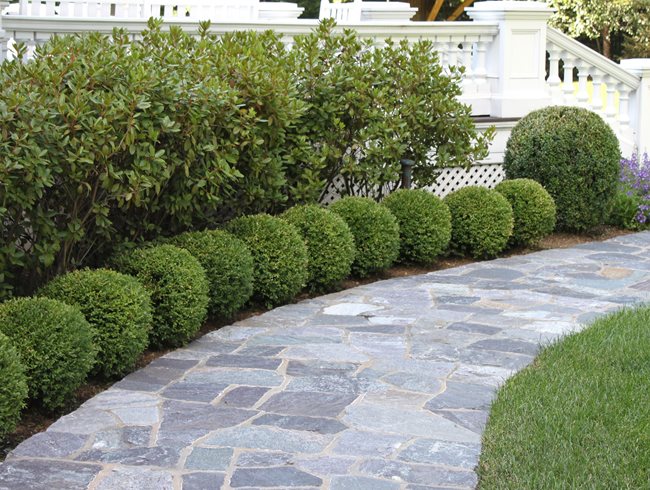
If you’re looking to spruce up your outdoor space, neat borders and landscape designs can make a big impact. Not only do they add visual appeal, but they also help define different areas and make it easier to maintain your landscaping.
One popular way to create neat borders is through the use of plastic or metal edging. These materials can be easily installed and help keep your lawn and garden separate. They’re also a great option if you have trouble with grass or weeds spreading into your garden beds.
Another approach to neatly defining your outdoor space is through the use of natural materials. A layer of mulch can be used to create a clean separation between your lawn and garden beds, while stones or bricks can be used to create a more defined border. For a more rustic look, consider using ornamental grasses to line your landscape.
When it comes to landscape designs, there are endless possibilities. Whether you prefer a formal garden with geometric shapes and perfectly manicured hedges, or a more natural look with meandering paths and wildflowers, there’s an option that will work for your taste and style.
Using different colors, textures, and heights in your landscaping can help create visual interest and draw the eye to different areas. For example, grouping plants of varying heights together can create a dynamic focal point, while a mix of flowers in different colors can add depth and richness to your landscape.
If you’re feeling overwhelmed by the options, consider consulting with a landscape designer to help create a plan that complements your outdoor space. With their expertise and knowledge of plants and design, they can help you bring your vision to life and create a beautiful and functional outdoor space.
Paver Patios with Outdoor Space Accentuated by Sharp Edges
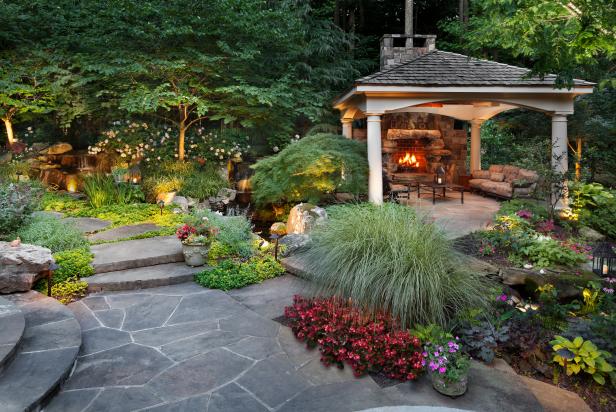
Paver patios are a popular option for homeowners who want to create a beautiful outdoor space that is both functional and visually appealing. One design trend that has gained traction in recent years is the use of sharp edges to accentuate the space around the patio.
Sharp edges are an exciting feature that can add a lot of curb appeal to your outdoor space. With sharp edges, you can create defined boundaries that separate different elements of your landscape, such as garden beds and lawn areas. This can make your outdoor space look more organized and polished.
When designing your patio space with sharp edges, you have many options for materials. Natural stone is a popular choice because it is durable and comes in a variety of sizes and colors. You can also use bricks or interlocking pavers to create a clean, straight edge.
In addition to adding beauty to your landscape, sharp edges can also have practical benefits. For example, they can make it easier to mow your lawn by creating a clear boundary between the grass and the patio area. Sharp edges can also prevent weeds from creeping into your patio, which can save you time and effort in the long run.
To create sharp edges around your patio, you will need to start by creating a narrow trench around the perimeter of your patio space. Use a rubber mallet to pound your chosen edging material into the trench. Then fill the trench with wet concrete or a layer of mulch to hold the edging material in place.
Overall, using sharp edges to accentuate your paver patio can be an excellent way to create a lovely outdoor space that is both functional and visually striking. If you’re looking for patio edge ideas, consider adding sharp edges to the design to give your outdoor space a clean, polished look.
Roof Gardens with Creative Patio Border Ideas and Designs
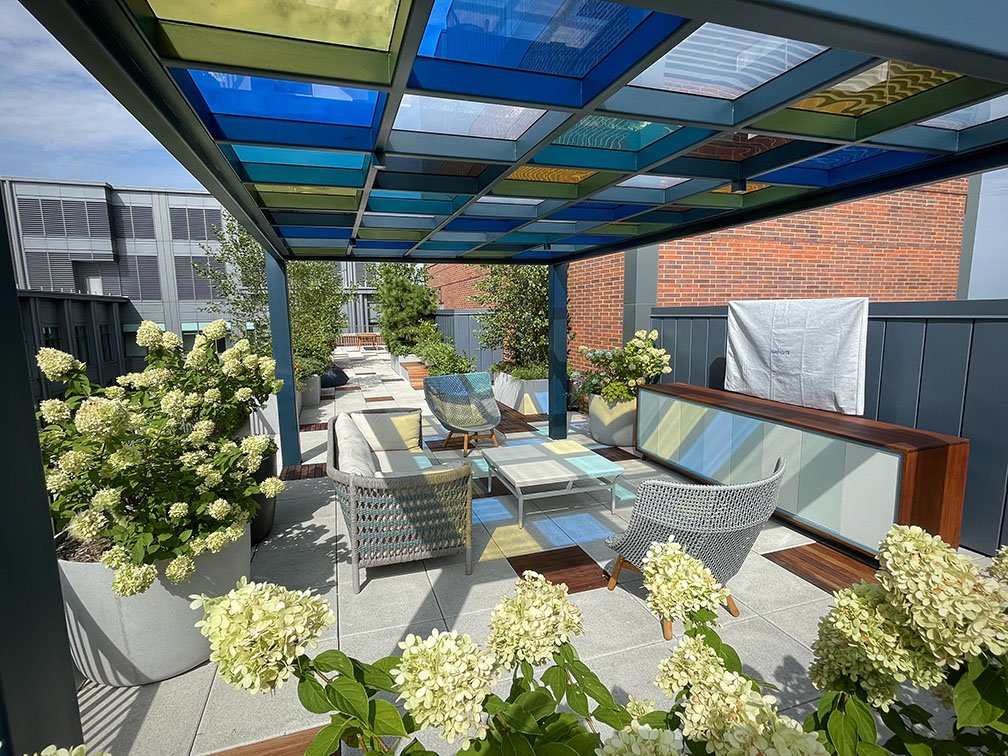
Roof gardens are becoming increasingly popular as more people seek to create beautiful outdoor spaces in urban areas. These gardens provide a much-needed escape from the hustle and bustle of city life and offer a peaceful retreat where people can relax, entertain and enjoy the beauty of nature. One of the key elements that can make a roof garden stand out is the patio border. With a little creativity, you can transform your roof garden into an oasis that is both functional and stylish.
When it comes to patio border ideas and designs for a roof garden, there are endless possibilities. You can opt for natural stone, interlocking pavers, bricks, or even metal edging. Each material offers a unique look and feel and can be used to create different effects. For example, natural stone can add a sense of rustic charm, while metal edging can create a clean and contemporary look.
Another great way to add interest to your patio border is by incorporating different shapes and patterns. Curved edges can soften the lines of a formal garden and add a sense of flow, while straight lines can create a more modern and streamlined look. If you have a rooftop garden with limited space, using raised garden beds and layering planters can help create a visually stunning effect.
Clever use of plants, flowers and ornamental grasses can also make your patio border stand out. A mix of flowering plants, such as dahlias and petunias, can create a riot of color and scent, while ornamental grasses, such as fountain grass or muhly grass, can add texture and movement to the garden. You can also use plants strategically to create a sense of privacy or to frame a particular view.
Lighting is another crucial element when it comes to creating a patio border that stands out at night. Investing in outdoor lighting can highlight the features of your patio border, such as the curves or textures of the materials used. You can also use lighting to draw attention to specific areas of the garden, such as a water feature or a particularly beautiful plant.
In conclusion, a well-designed patio border can make all the difference in creating a beautiful and functional roof garden. Whether you go for a natural look or a more contemporary style, incorporating creative patio border ideas and designs can help you create an outdoor space that is truly special. With the right materials, shapes and textures, and a touch of imagination, you can create a roof garden that stands out and provides a peaceful escape from the busy urban environment.

